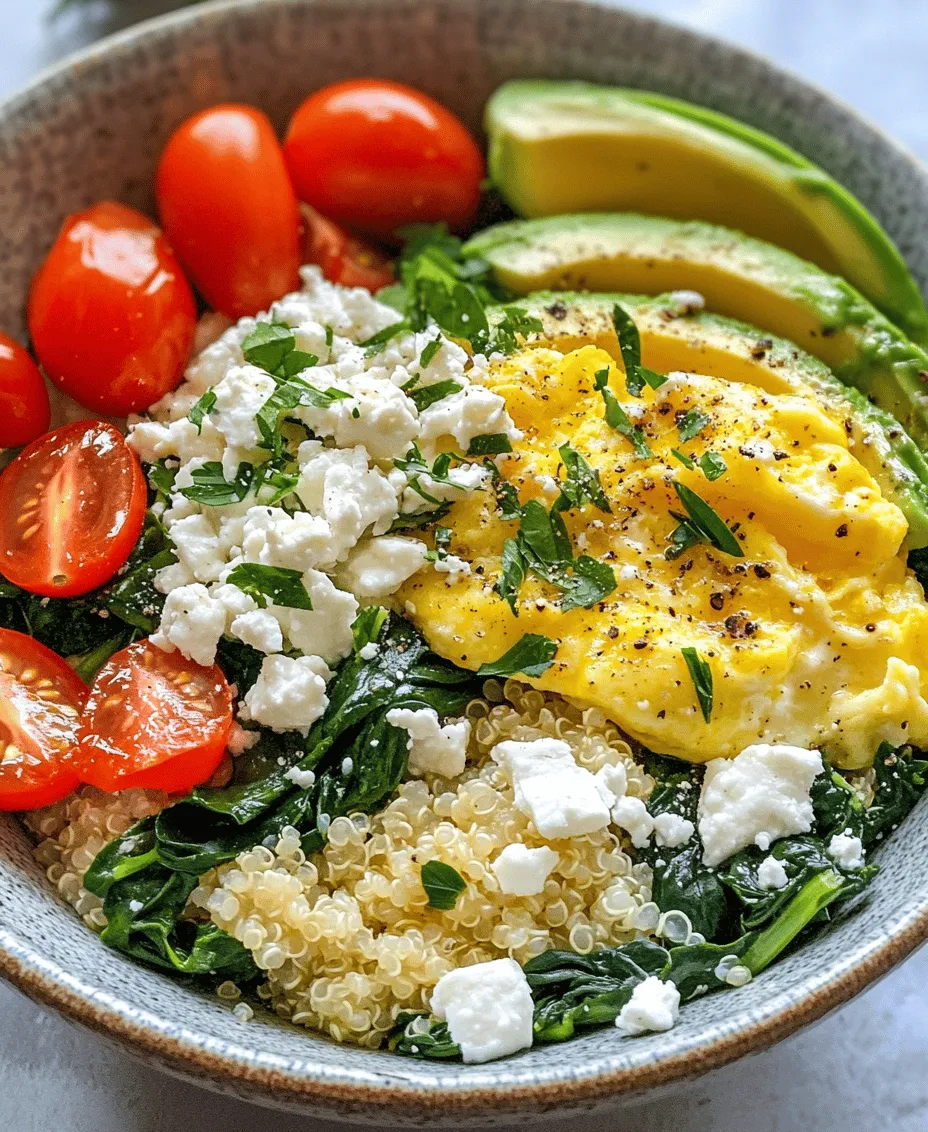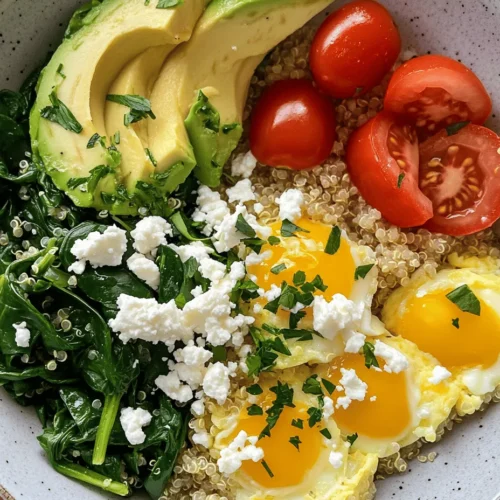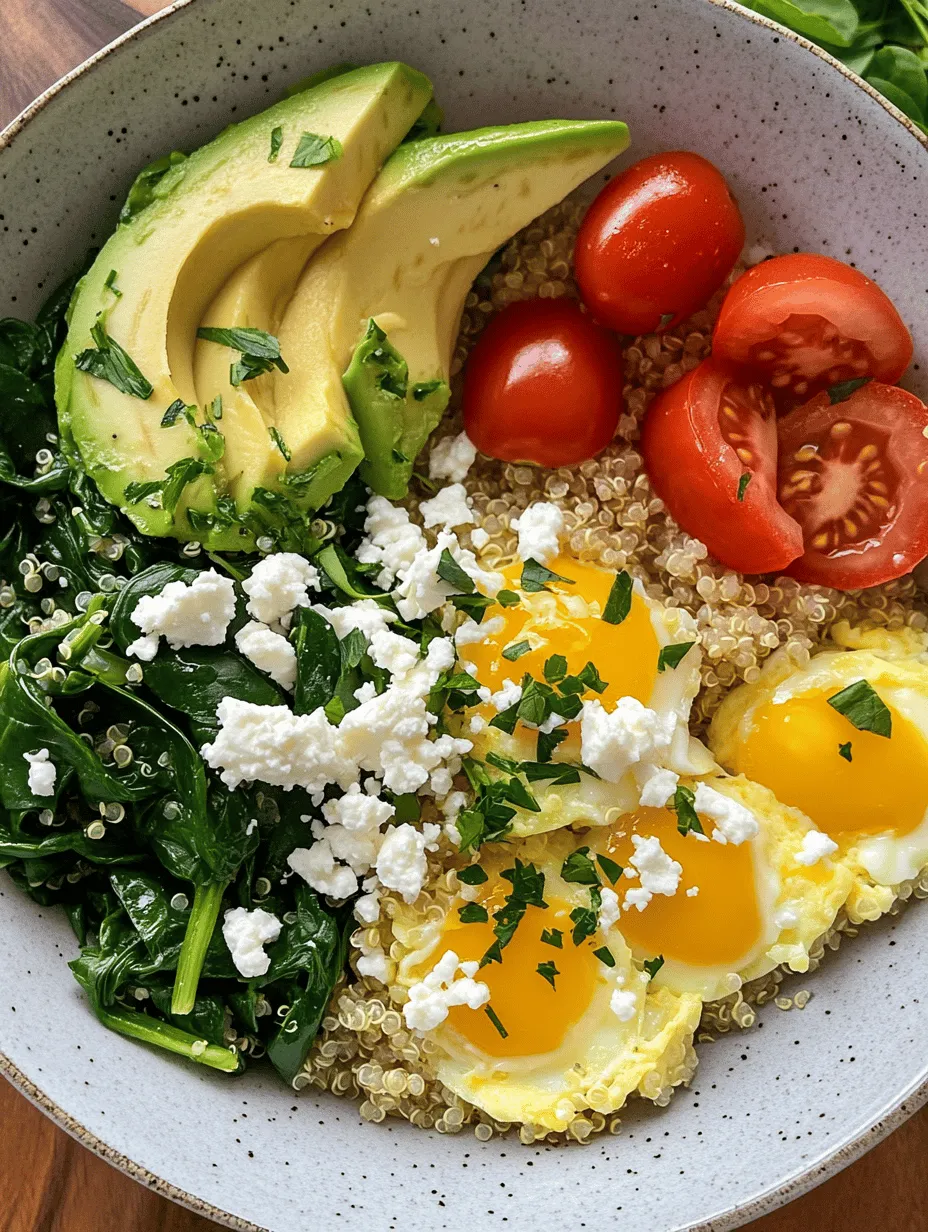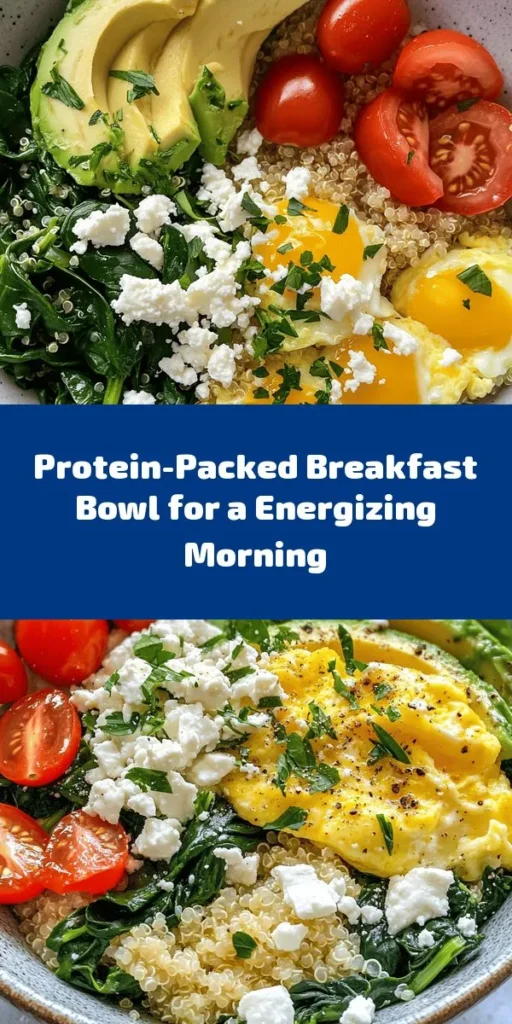Introduction to High Protein Breakfast Bowls
Breakfast is often heralded as the most important meal of the day, and for good reason. It sets the tone for your energy levels and nutritional intake throughout the day. A well-rounded breakfast can enhance your focus, maintain stable blood sugar levels, and keep hunger at bay until your next meal. However, many individuals often overlook the nutritional quality of their morning meals, opting for quick and convenient options that lack adequate sustenance. One of the healthiest and most satisfying ways to kickstart your morning is with a high protein breakfast bowl.
High protein breakfast bowls are a delightful way to incorporate a variety of healthy ingredients into your morning routine. These bowls not only provide essential nutrients but also offer a delicious and satisfying way to enjoy a meal. This article will delve into an easy and flavorful recipe for high protein breakfast bowls featuring quinoa, eggs, and fresh vegetables. We’ll explore the nutritional benefits of each ingredient and provide a step-by-step guide to creating this wholesome meal that will keep you energized and satisfied throughout your morning.
Understanding the Importance of Breakfast
The Role of Breakfast in Daily Nutrition
Breakfast plays a crucial role in our daily nutrition. After a long night of fasting, your body needs a replenishment of energy and nutrients to start the day. Skipping breakfast can lead to decreased concentration, irritability, and low energy levels, making it difficult to tackle daily tasks. A balanced breakfast that includes carbohydrates, fats, and proteins can help stabilize blood sugar levels, provide lasting energy, and promote overall health. Research has shown that individuals who eat breakfast tend to consume more vitamins and minerals throughout the day, leading to improved overall dietary quality.
Benefits of Consuming Protein in the Morning
Protein is an essential macronutrient that supports muscle repair, growth, and overall bodily functions. Including protein in your breakfast can provide numerous benefits. Firstly, protein helps to keep you feeling fuller for longer, which can prevent unnecessary snacking later in the day. Additionally, consuming protein in the morning can enhance metabolic rate, as the body requires more energy to digest protein compared to fats and carbohydrates. This thermogenic effect can contribute to weight management and improved body composition. Furthermore, protein-rich breakfasts can help stabilize blood sugar levels, preventing energy crashes and mood swings throughout the morning.
How Breakfast Influences Metabolism and Energy Levels
Eating a balanced breakfast can significantly influence your metabolism and energy levels. When you consume a meal that combines protein, healthy fats, and complex carbohydrates, your body is better equipped to regulate blood sugar levels. This regulation helps avoid spikes and crashes in energy, allowing you to maintain focus and productivity. Studies have shown that individuals who consume breakfast regularly tend to have better metabolic markers compared to those who skip this important meal. Additionally, a hearty breakfast can kickstart your metabolism for the day, promoting effective calorie burning and weight management.
Exploring High Protein Ingredients
When it comes to assembling a high protein breakfast bowl, the choice of ingredients is vital. Each component contributes unique nutritional benefits, ensuring a well-rounded meal. Let’s explore some key ingredients that can elevate your breakfast bowl.
Quinoa: A Complete Protein Source
Quinoa has gained popularity as a superfood, and for good reason. This gluten-free grain is not only versatile but also packs a powerful protein punch. Unlike many plant-based protein sources, quinoa is a complete protein, meaning it contains all nine essential amino acids that the body cannot produce on its own. In addition to protein, quinoa is rich in fiber, vitamins, and minerals, making it a fantastic base for your breakfast bowl. It provides a nutty flavor and a satisfying texture that pairs well with various ingredients.
Eggs: Nutritional Powerhouses
Eggs are often regarded as one of the best sources of protein available. They are incredibly nutrient-dense, providing essential vitamins and minerals such as vitamin B12, selenium, and choline. The protein content in eggs is highly bioavailable, meaning your body can easily absorb and utilize it. Moreover, eggs contain healthy fats, which are essential for maintaining energy levels and supporting brain function. Cooking eggs to your preference—scrambled, poached, or fried—adds a creamy texture and rich flavor to your breakfast bowl.
Spinach: Packed with Vitamins and Minerals
Leafy greens like spinach are excellent additions to any breakfast bowl. Spinach is low in calories but high in vitamins A, C, and K, as well as iron and antioxidants. These nutrients contribute to overall health and wellness, supporting immune function and promoting skin health. When added to a breakfast bowl, spinach provides a fresh and vibrant contrast to heartier ingredients. It can be sautéed, wilted, or even enjoyed raw, depending on your preference.
Avocado: Healthy Fats for Sustained Energy
Avocado has gained a reputation as a superfood due to its impressive nutritional profile. Rich in heart-healthy monounsaturated fats, fiber, and potassium, avocado is a fantastic addition to your breakfast bowl. The healthy fats in avocado promote satiety and provide sustained energy, helping you power through your morning activities. Additionally, avocados are versatile and can be sliced, mashed, or blended into your breakfast bowl, adding creaminess and flavor.
Feta Cheese: Flavorful and Nutritious Addition
Feta cheese is a tangy and flavorful dairy product that can elevate the taste of your breakfast bowl. While higher in fat than some other cheeses, feta is lower in calories and provides a good source of protein and calcium. Its crumbly texture and bold flavor pair well with the other ingredients, adding depth to your dish. For those looking for a lower-fat option, reduced-fat feta is available and can be substituted without compromising taste.
The Benefits of Fresh Herbs
Fresh herbs can add an aromatic touch to your breakfast bowl, enhancing its flavor profile without adding calories. Herbs like parsley, cilantro, or chives can provide a burst of freshness that complements the other ingredients. Additionally, many herbs are rich in antioxidants and essential nutrients, contributing to your overall health. Simply chop and sprinkle them over your bowl for an extra layer of flavor and color.
Ingredients Breakdown for Easy High Protein Breakfast Bowls
To create your easy high protein breakfast bowls, you will need a selection of fresh and nutritious ingredients. Here’s a detailed list of what you will need:
Detailed List of Ingredients
1. Quinoa: 1 cup (uncooked)
– A complete protein source that serves as the foundation of the breakfast bowl.
2. Eggs: 2 large
– Provides high-quality protein and essential nutrients.
3. Fresh Spinach: 1 cup (washed and chopped)
– Adds vitamins and minerals along with a fresh flavor.
4. Avocado: 1 medium (sliced or mashed)
– Offers healthy fats and creaminess to the bowl.
5. Feta Cheese: 1/4 cup (crumbled)
– Adds a tangy flavor and additional protein.
6. Fresh Herbs: 2 tablespoons (chopped, such as parsley or cilantro)
– Enhances flavor and nutritional value.
7. Olive Oil: 1 tablespoon (for cooking and drizzling)
– Provides healthy fats and enhances flavor.
8. Salt and Pepper: To taste
– Essential for seasoning.
Nutritional Information of Each Ingredient
– Quinoa: Approximately 222 calories, 8g protein, 39g carbohydrates, 3.6g fat per cooked cup.
– Eggs: About 70 calories, 6g protein, 0.6g carbohydrates, 5g fat per large egg.
– Spinach: Roughly 7 calories, 1g protein, 1g carbohydrates, 0.1g fat per cup.
– Avocado: Approximately 240 calories, 3g protein, 12g carbohydrates, 22g fat per medium avocado.
– Feta Cheese: About 100 calories, 6g protein, 1g carbohydrates, 8g fat per 1/4 cup.
– Olive Oil: Approximately 119 calories, 0g protein, 0g carbohydrates, 14g fat per tablespoon.
Suggestions for Ingredient Substitutions
While the ingredients listed above create a delicious and nutritious high protein breakfast bowl, feel free to experiment with substitutions based on your preferences or dietary needs:
– Quinoa: Substitute with farro, barley, or brown rice for different flavors and textures.
– Eggs: Use scrambled tofu or chickpea flour for a plant-based option.
– Spinach: Kale, arugula, or Swiss chard can be used as alternatives.
– Avocado: Replace with hummus or nut butter for a different taste.
– Feta Cheese: Goat cheese or nutritional yeast can provide similar flavors for a dairy-free option.
Step-by-Step Instructions for Preparation
Now that you have your ingredients ready, let’s walk through the step-by-step process of preparing your easy high protein breakfast bowls.
Cooking Quinoa: Tips for Perfectly Fluffed Grains
1. Rinse the Quinoa: Start by rinsing 1 cup of quinoa under cold water in a fine-mesh sieve. This step helps remove any bitterness from the quinoa’s natural coating known as saponin.
2. Cook the Quinoa: In a medium saucepan, combine the rinsed quinoa with 2 cups of water or broth for added flavor. Bring the mixture to a boil over medium-high heat. Once boiling, reduce the heat to low, cover, and let it simmer for about 15 minutes or until the quinoa has absorbed all the liquid.
3. Fluff the Quinoa: After cooking, remove the saucepan from the heat and let it sit, covered, for 5 minutes. This resting period allows the quinoa to steam and become fluffy. Finally, use a fork to fluff the quinoa, separating the grains.
With quinoa prepared, you’re well on your way to assembling a delicious, high protein breakfast bowl that will fuel your day ahead. In the next section, we will continue with additional steps to complete your breakfast bowl and explore the delightful combination of flavors and textures that make this meal a favorite among health enthusiasts.

Sautéing Spinach: Best Techniques for Flavorful Greens
Sautéing spinach is a straightforward technique that enhances its flavor while retaining its vibrant green color and nutritional benefits. Begin by washing your spinach thoroughly to remove any dirt or grit. It’s essential to dry the leaves properly; excess moisture can lead to steaming rather than sautéing.
1. Heat the Pan: Start by heating a tablespoon of olive oil or your preferred cooking oil in a large skillet over medium heat. Allow the oil to heat until it shimmers, signaling that it’s ready for cooking.
2. Add Aromatics: For an extra layer of flavor, consider adding minced garlic or chopped onions to the oil before adding the spinach. Sauté these aromatics for about 30 seconds until fragrant, but be careful not to burn them.
3. Add Spinach: Gradually add the spinach to the pan. It may seem like a lot initially, but spinach wilts down significantly. Stir frequently to coat the leaves evenly with oil and to promote even cooking.
4. Cooking Time: Sauté the spinach for 2 to 3 minutes until it is wilted but still bright green. Overcooking can lead to a mushy texture and loss of nutrients. Season with salt and pepper to taste just before removing from heat.
5. Serving: Use the sautéed spinach as a base or layer in your breakfast bowl. It adds a nutritious boost and pairs wonderfully with the eggs and other toppings.
Cooking Eggs: Various Methods and Their Benefits
Eggs are the centerpiece of any breakfast bowl, providing a hearty dose of protein. There are several cooking methods to choose from, each offering unique flavors and textures.
1. Scrambled Eggs: This method is quick and easy. Whisk together eggs with a splash of milk and season with salt and pepper. Pour the mixture into a heated, greased skillet over medium heat, stirring gently until the eggs are just set. Scrambled eggs are soft and creamy, making them a popular choice for breakfast bowls.
2. Fried Eggs: For a sunny-side-up or over-easy egg, heat a small amount of oil or butter in a skillet. Crack the egg into the pan and cook until the whites are set but the yolk remains runny. Fried eggs add a rich, buttery flavor and a delightful texture contrast in your bowl.
3. Poached Eggs: Poaching eggs can seem daunting, but it’s straightforward. Bring a pot of water to a gentle simmer and add a dash of vinegar. Crack the egg into a small bowl, then gently slide it into the water. Cook for about 3-4 minutes for a soft yolk. Poached eggs are light and elegant, perfect for a sophisticated breakfast bowl.
4. Hard-Boiled Eggs: For meal prep convenience, hard-boiled eggs are ideal. Boil the eggs for about 9-12 minutes, then cool them in ice water to stop the cooking process. Slice them up for your breakfast bowl, providing a firm texture and protein boost without the extra fat.
Assembling the Bowl: Presentation and Layering Techniques
The presentation of your breakfast bowl can elevate the whole meal experience. Here’s how to assemble it for maximum appeal:
1. Base Layer: Start with a base of grains or greens. Quinoa, brown rice, or even mixed greens work beautifully. This layer provides a hearty foundation and adds fiber to your dish.
2. Protein Layer: Next, add your cooked protein—whether it’s scrambled eggs, poached eggs, or even tempeh or tofu for a plant-based option. Place the eggs in the center to create a focal point.
3. Vegetable Layer: Incorporate sautéed spinach and any other vegetables you desire, such as diced tomatoes, roasted bell peppers, or sliced avocado. This adds color, texture, and flavor.
4. Garnishing: Finally, sprinkle your chosen toppings over the bowl. Consider using microgreens, fresh herbs, cheese, or seeds for added crunch and nutrition. The key is to balance flavors and colors to make the dish visually appealing.
Garnishing: Elevating Flavor with Toppings
Garnishing your breakfast bowl is not just about aesthetics; it’s also an opportunity to add flavor and nutrition. Here are some ideas to consider:
1. Herbs: Fresh herbs like parsley, cilantro, or chives can add brightness and depth to your bowl. Chop them finely and sprinkle them on top right before serving.
2. Cheese: A sprinkle of feta, goat cheese, or shredded cheddar can introduce a creamy texture and rich flavor. Choose cheese varieties that complement the other ingredients.
3. Seeds and Nuts: Toasted seeds (like pumpkin or sunflower seeds) or nuts (like slivered almonds or walnuts) can provide a satisfying crunch. They also contribute healthy fats and additional protein.
4. Hot Sauce or Salsas: If you enjoy a kick in your breakfast, consider drizzling hot sauce or adding a spoonful of salsa for a zesty finish.
5. Avocado: Sliced or smashed avocado not only enhances the richness of the bowl but also adds healthy fats and a creamy texture.
Nutritional Analysis of the Breakfast Bowl
Understanding the nutritional content of your breakfast bowl can help you make informed choices about your meals. Here’s a breakdown of typical ingredients:
Calories and Macronutrient Breakdown
– Base (Quinoa): A cup of cooked quinoa contains about 222 calories, 8 grams of protein, 39 grams of carbohydrates, and 4 grams of fat.
– Eggs: One large egg contains approximately 70 calories, 6 grams of protein, 0.6 grams of carbohydrates, and 5 grams of fat.
– Spinach: One cup of cooked spinach has about 40 calories, 5 grams of protein, 7 grams of carbohydrates, and 0.5 grams of fat.
– Avocado: A half avocado contributes about 120 calories, 1.5 grams of protein, 6 grams of carbohydrates, and 11 grams of fat.
When combined, a breakfast bowl can offer a satisfying meal with roughly 400-500 calories, depending on portion sizes, while delivering a balanced mix of protein, healthy fats, and complex carbohydrates.
Vitamins and Minerals Provided by Each Ingredient
Each component of your breakfast bowl contributes essential vitamins and minerals:
– Quinoa: Rich in magnesium, iron, and B vitamins.
– Eggs: High in vitamin D, B12, and selenium.
– Spinach: Excellent source of iron, calcium, and vitamins A, C, and K.
– Avocado: Provides potassium, vitamin E, and folate.
Combining these ingredients in a breakfast bowl ensures you start the day with a nutrient-dense meal that fuels your body effectively.
Health Benefits of Consuming a High Protein Breakfast
Starting your day with a high protein breakfast has several health benefits:
1. Satiety: Protein is known for its ability to keep you feeling full longer, helping to curb mid-morning snacking.
2. Muscle Maintenance: Regular protein intake supports muscle repair and growth, making it ideal for anyone with an active lifestyle.
3. Stable Energy Levels: A high protein breakfast can stabilize blood sugar levels, providing sustained energy throughout the day.
4. Cognitive Function: Protein-rich meals can enhance focus and concentration, making it easier to tackle your daily tasks.
Customizing Your Breakfast Bowl
One of the best features of a breakfast bowl is its versatility. Here’s how you can customize it to suit your preferences:
Variety of Optional Toppings
Experimenting with different toppings can keep your breakfast exciting. Consider adding:
– Fruits: Fresh fruits like berries, sliced bananas, or citrus segments can add a sweet contrast.
– Legumes: Chickpeas or black beans can provide additional protein and fiber.
– Whole grains: Swap quinoa for brown rice, farro, or barley for a different texture and flavor.
Exploring Different Flavor Profiles
You can change the flavor profile of your breakfast bowl with different spices and herbs. Try:
– Mediterranean: Use olives, feta cheese, and a drizzle of olive oil.
– Mexican: Incorporate black beans, salsa, avocado, and cilantro.
– Asian: Include tofu, sesame oil, and scallions for a unique twist.
Dietary Considerations: Vegetarian, Vegan, and Gluten-Free Options
Your breakfast bowl can easily accommodate various dietary preferences:
– Vegetarian: Stick with eggs and dairy toppings for a wholesome vegetarian meal.
– Vegan: Substitute eggs with tofu scramble or chickpea flour scramble, and use nutritional yeast for a cheesy flavor.
– Gluten-Free: Most ingredients are naturally gluten-free, making this breakfast bowl a safe choice for those with gluten sensitivities.
Serving Suggestions and Meal Prep Ideas
Integrating breakfast bowls into your routine can enhance your meal planning. Here’s how:
Best Times to Enjoy Breakfast Bowls
Breakfast bowls are not just for breakfast! Consider enjoying them at any meal throughout the day, whether for a hearty brunch, a light lunch, or even dinner. They are versatile enough to suit any time.
How to Incorporate Breakfast Bowls into Weekly Meal Prep
Meal prepping can save time during busy weekdays. Here are some tips:
1. Batch Cook Grains: Prepare a large batch of quinoa or rice at the beginning of the week.
2. Prep Vegetables: Wash and chop vegetables in advance, storing them in airtight containers for easy access.
3. Cook Eggs in Advance: Hard-boil eggs and store them in the refrigerator for quick assembly.
Storing Leftovers and Reheating Tips
If you have leftovers, store them in airtight containers in the refrigerator. Most ingredients will keep well for 3-4 days. When reheating:
– Microwave: Heat in short bursts to avoid drying out.
– Stovetop: Add a splash of water to the pan and cover to steam while reheating.
Conclusion: The Benefits of High Protein Breakfast Bowls
High protein breakfast bowls are a fantastic way to start your day on a nutritious note. They offer a balanced meal filled with essential nutrients, keeping you energized and satisfied. Incorporating a variety of ingredients allows for endless customization, making it easy to tailor to your taste preferences and dietary needs.
By making high protein breakfast bowls a regular part of your routine, you can enhance your overall health and well-being. Remember, a healthy breakfast sets the tone for the day—so why not make it delicious, nutritious, and satisfying? Embrace this healthy eating habit, and enjoy the numerous benefits that come with it.



